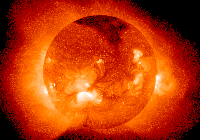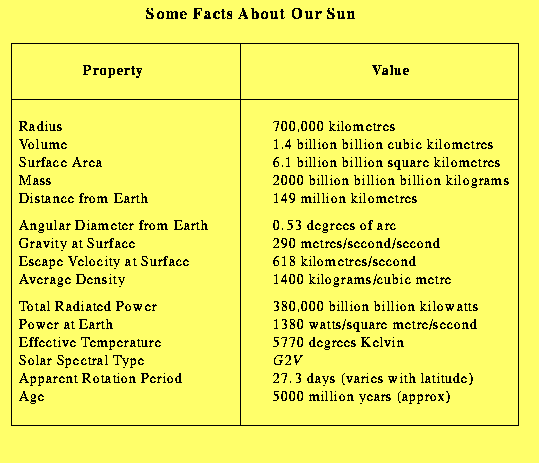The Sun In Space: What's It All About?

|
We see the sun every day, but what do we really know about it? Here are some of the sun's vital statistics to get you started:
|

Our sun is just another star, like others we see in the night sky. Specifically, it is known as a yellow dwarf star .
The sun is very important to us, but it is relatively average when compared to other stars in the universe. It creates about 4.0E023 kilowatts of
energy each second, and has been doing so for about 4 or 5 billion years. We should note that the Earth recieves only
about 1-two billionth of the energy produced by the sun. This is a good thing: if we got much more of it, we could not survive.
Solar Anatomy:
The sun has the diameter of about 109 Earths and the volume of 1.25 million Earths--it's big! It is about 150 billion meters from
Earth, and it takes light about 8 minutes to travel from our sun to Earth.
The sun is made up of several layers of matter: the core, the radiation zone, and the convection zone. There is also the photosphere, which is the surface of the sun and is discussed below.
- In the core, hydrogen is fused to form helium. This helium then radiates off into space as heat and light. Scientists think that the temperature in the core is about 15,000,000 degrees Celsius. That's hot!
- The convection zone is the outer 30% of the sun. Here, large bubbles of gas that are slightly hotter than their surroundings become buoyant and will rise to the surface (the photosphere). Meanwhile, cooler bubbles will sink.
There are 3 basic layers of gas around the sun: the photosphere , the chromosphere , and the corona.
- The photosphere is the first outer shell of the sun. It is this layer that radiates most of the visable energy,
or light, that we see. The pressure here is 1/10th that of the surface of the Earth.
- The chromosphere also has glowing gasses, but we can rarely see them from Earth. During a solar eclipse, they
may be visable using a special filter. This is also the area where solar flares occur. The chromosphere is only a few thousand kilometers thick.
- The corona is a ring of ionized gasses that are only visable during an eclipse. It does not have a very bright
light, only about half of what we see during a full moon.
Solar Events:
Solar flares are commonly defined as sudden and intense variations in brightness. They are believed to result
from the build-up and explosive release of magnetic energy in the solar atmosphere. Some of the signs of a flare are gas rapidly heated to high temperatures,
electrons and ions accelerated to high energies, and bulk mass motion.
Sunspots can often be observed on the sun's surface. They may change in size and even location, but they are usually there.
A sunspot is defined as a temporary disturbed area in the solar photosphere that appears dark because it is cooler than the surrounding areas.
Sunspots consist of concentrations of strong magnetic flux. They usually occur in pairs or groups of opposite polarity that move in unison across the face of the Sun
as it rotates.
The Future: What is next for our Sun?
Despite many dire predictions that our sun will collapse at any time, it should continue to produce energy for another 5 billion years. At this time, the sun will become a degenerate dwarf star.
The center of the sun is largely hydrogen gas. When this hydrogen is used up and converted into helium, the sun will be a red giant star. During this time, the core of the sun will collapse, pressed together by its own gravity.
Thermonuclear reactions from the fusion of hydrogen and helium will create a new surge of power and the outer layers of the sun will expand until it has a diameter of about 1000 times its present value. At this point, the sun will envelope the inner planets, including Earth.
When this energy is used up, after about 100 million years, the sun will begin to collapse again, until it becomes a white dwarf star about the size of the Earth. At this time, the sun will be only a fraction of its current brightness.
Back to SUNBEAMS home page







